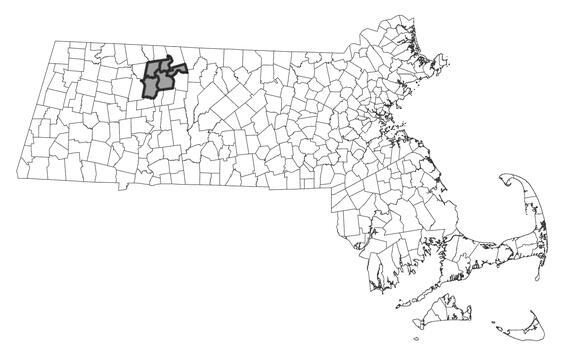- Scientific name: Deschampsia cespitosa ssp. glauca
- Species of Greatest Conservation Need (MA State Wildlife Action Plan)
- Endangered (MA Endangered Species Act)
Description
Tussock hairgrass is a perennial member of the grass family (Poaceae) found on rocky and gravelly river shores. Its stems are 7-75 cm (3-30 in) tall, topped with conspicuous, branched inflorescences that are 2-22 cm (0.8-8.7 in) long. The leaves are flat or folded and 1-5 mm (0.04-0.2 in) wide; the lowest leaves are up to 8 cm (3.15 in) long. The scientific name refers to the characteristic tufted growth form and whitish bloom.
A technical manual should be consulted for identification of grass species. The basic flowering unit of grasses is a spikelet, which may have a pair of bracts (glumes) at its base. A spikelet is comprised of one to many individual flowers (florets). Each floret has a pair of bracts at its base called the lemma and the palea. In hairgrasses (Deschampsia spp.) found in Massachusetts, the spikelets are up to 7 mm (0.28 in) long, with two florets and a hairy rachilla that projects beyond the base of the upper lemma. The glumes are about the same length as the lemmas. The lemmas are rounded on the back, with a tuft of hairs at the base and five faint veins; the midrib diverges at or below the middle into a short bristle (awn). Tussock hairgrass differs from other hairgrasses by having stems no more than 75 cm (~29 in) tall, with leaves up to 5 mm (0.2 in) wide and no more than 8 cm (3.15 in) long.
Common hairgrass (Deschampsia flexuosa) is found throughout Massachusetts in sunny, rocky or sandy areas, sometimes growing alongside tussock hairgrass. It differs from tussock hairgrass in having narrower (1–2 mm [0.04-0.08 in]) and inrolled leaves. The lemmas of common hairgrass are also minutely rough or pubescent and have a conspicuously bent awn that projects 1 to 3 mm (0.04-0.12 in) beyond the lemmas; tussock hairgrass has smooth lemmas with awns that are more or less straight and shorter than or only slightly projecting beyond the lemmas. The palea of common hairgrass is not cleft at the tip as it is in tussock hairgrass. An introduced subspecies, D. cespitosa ssp. cespitosa, found primarily in open, human-disturbed habitats, is similar to tussock hairgrass but is not glaucous and is substantially larger. D. cespitosa ssp. cespitosa has stems 65-170 cm (26-67 in) tall and 2-6 mm (0.08-0.24 in) thick near the base, with long panicles (15-45 cm [5.9-17.7 in]). Its lower stem leaves are 15-50 cm (5.9-20 in) long. It has long ligules (5-10 mm [0.2-0.4 in]) and spikelets that are 2.5-7 mm (0.1-0.3 in) long. Tussock hairgrass has shorter lower stem leaves (1-8 cm [0.4-3.1 in]), shorter ligules (3-4 mm [0.12-0.16 in]), and spikelets that are 3-4.5 mm (0.12-0.18 in).
Life cycle and behavior
This is a perennial grass.
Population status
Tussock hairgrass is listed under the Massachusetts Endangered Species Act as Endangered. All listed species are protected from killing, collecting, possessing, or sale, and from activities that would destroy habitat and thus directly or indirectly cause mortality or disrupt critical behaviors. Tussock hairgrass occurs in Franklin, Hampshire, and Hampden Counties, and was found historically along the Merrimack River in Middlesex County. It is considered introduced in Norfolk County. The Massachusetts Natural Heritage & Endangered Species Program database has 9 records from 3 counties: Franklin, Hampden, and Hampshire. Six of these records have been observed within the last 25 years.
Distribution and abundance
Tussock hairgrass is found in eastern North America from Canada south to Illinois, Kentucky, and North Carolina. It is listed as Endangered in Kentucky, Maryland and Massachusetts; Special Concern in Connecticut; and Rare in Indiana.

Distribution in Massachusetts
1999-2024
Based on records in the Natural Heritage Database
Habitat
The known occurrences of tussock hairgrass in Massachusetts are all on river-scoured bedrock, cobble, or gravel shores along the Connecticut River.
Healthy habitats are vital for supporting native wildlife and plants. Explore habitats and learn about conservation and restoration in Massachusetts.
Threats
Tussock hairgrass habitat is maintained by regular flooding and scouring; existing populations would be threatened by damming or other alteration of hydrological conditions. All active management of rare plant populations (including invasive species removal) is subject to review under the Massachusetts Endangered Species Act and should be planned in close consultation with MassWildlife’s Natural Heritage & Endangered Species Program.
Conservation
As for many rare species, exact needs for management of tussock hairgrass are not known. All active management of rare plant populations (including invasive species removal) is subject to review under the Massachusetts Endangered Species Act and should be planned in close consultation with MassWildlife’s Natural Heritage & Endangered Species Program.
References
Gleason, H. A., and A. Cronquist. 1991. Manual of Vascular Plants of Northeastern United States and Adjacent Canada, 2nd edition. The New York Botanical Garden, Bronx, NY.
Haines, A. 2011. Flora Novae Angliae – a Manual for the Identification of Native and Naturalized Higher Vascular Plants of New England. New England Wildflower Society, Yale Univ. Press, New Haven, CT
Contact
| Date published: | April 15, 2025 |
|---|